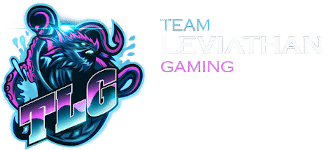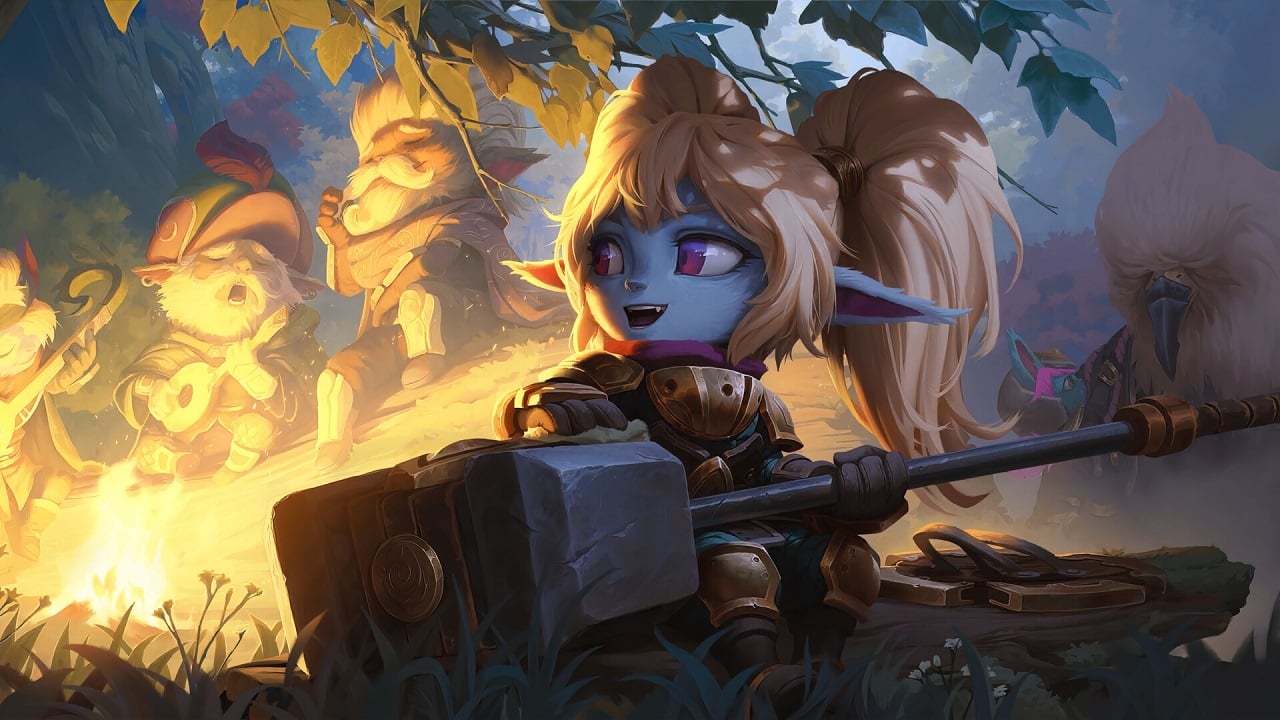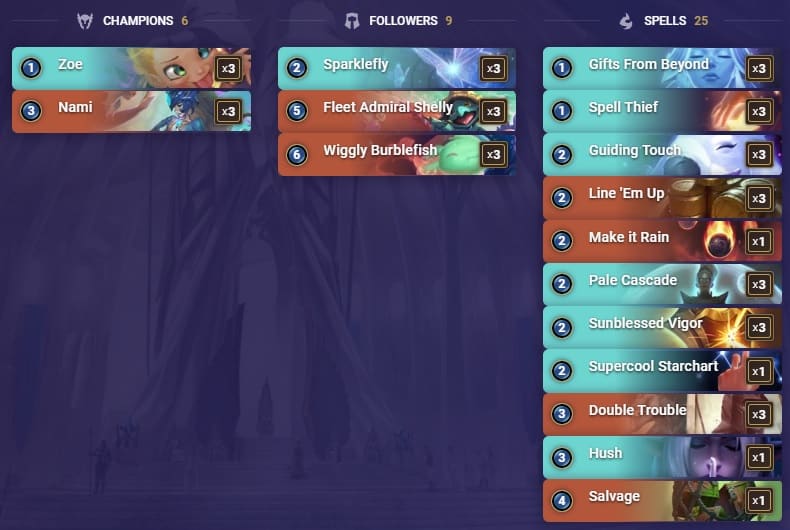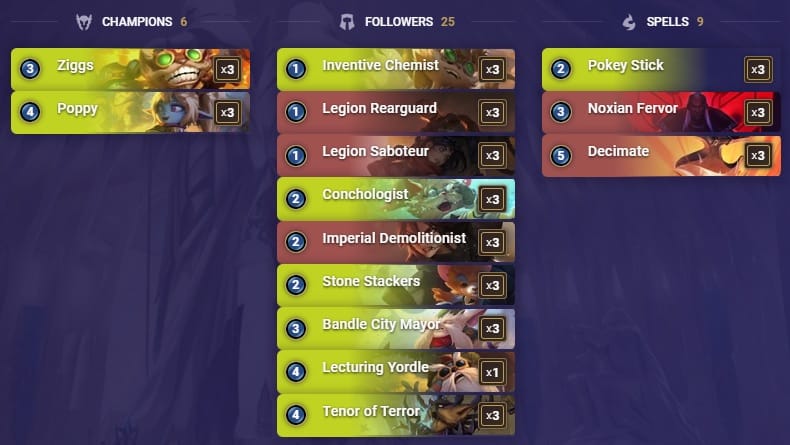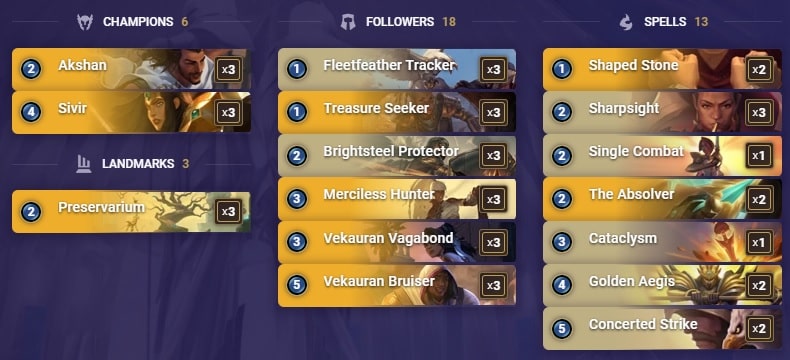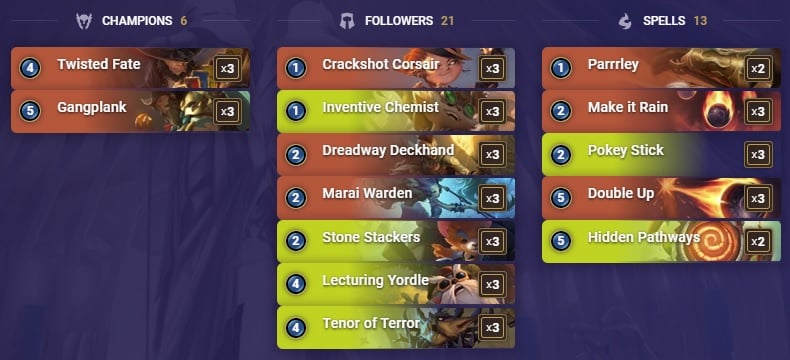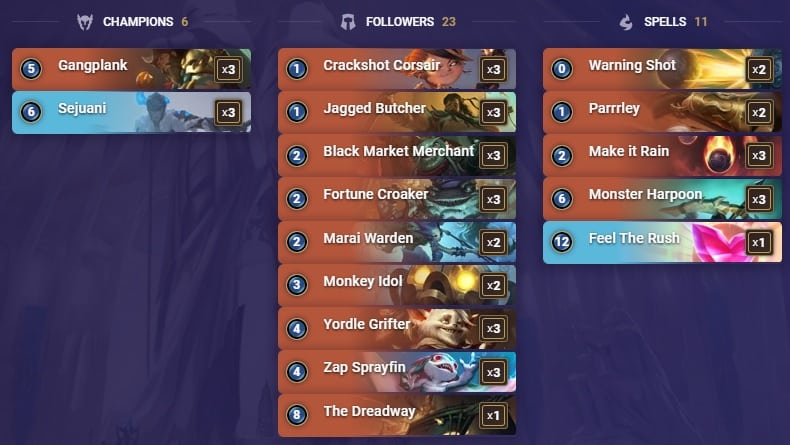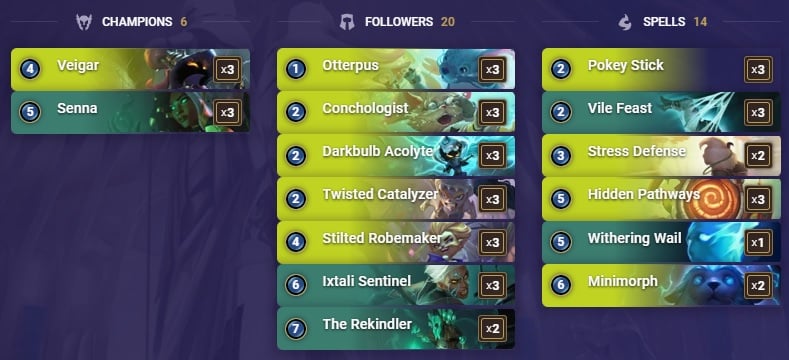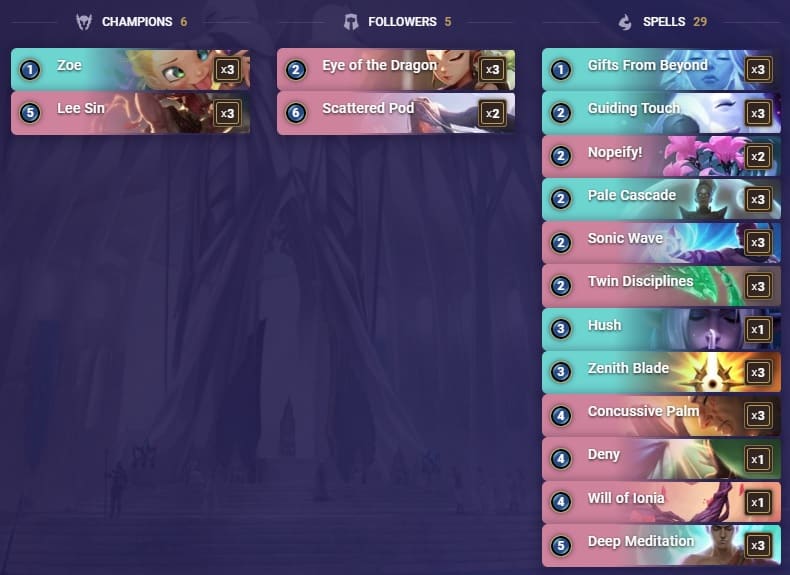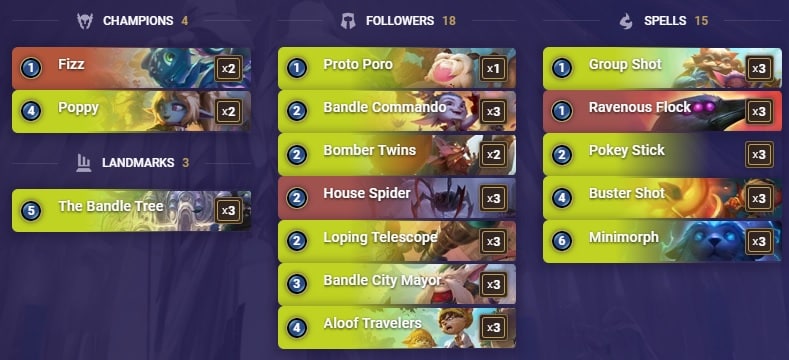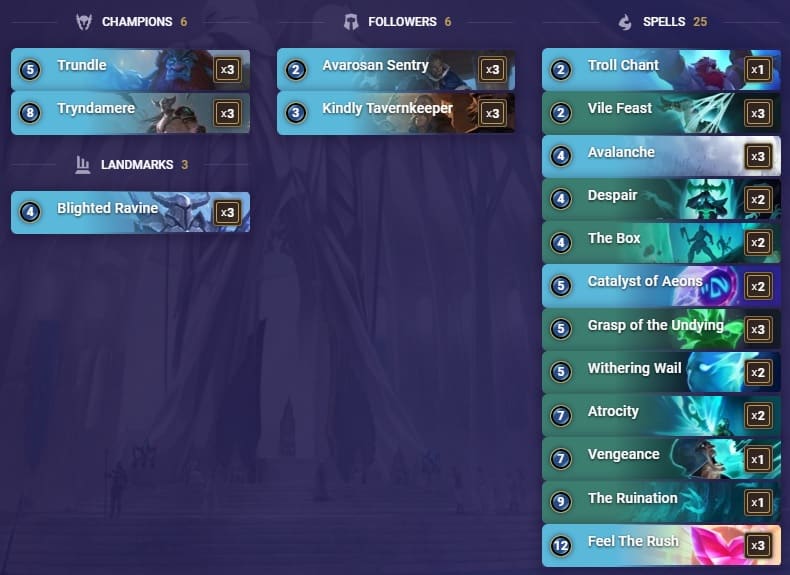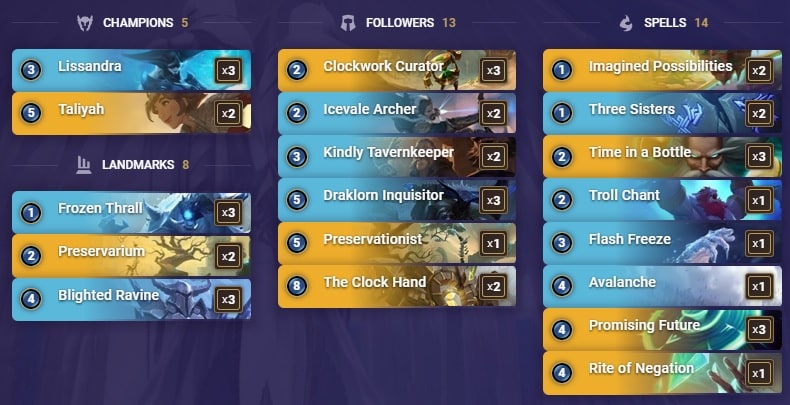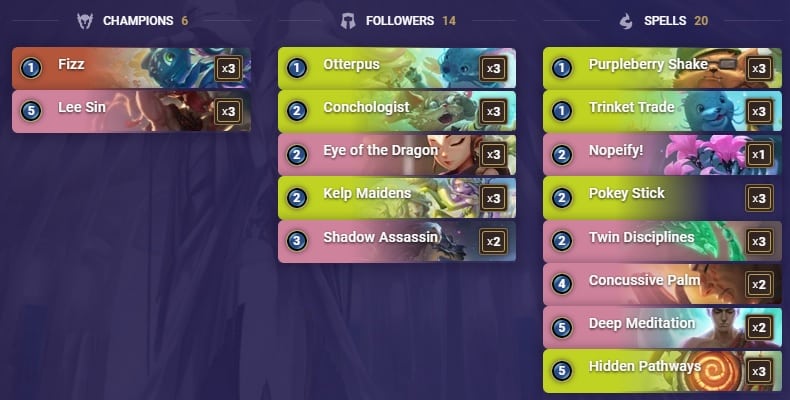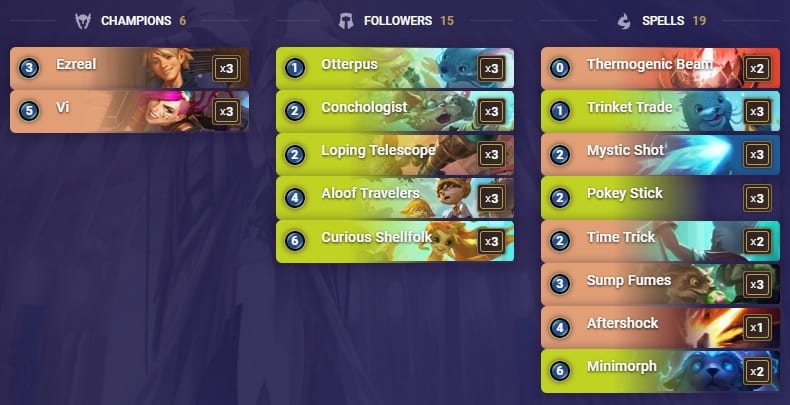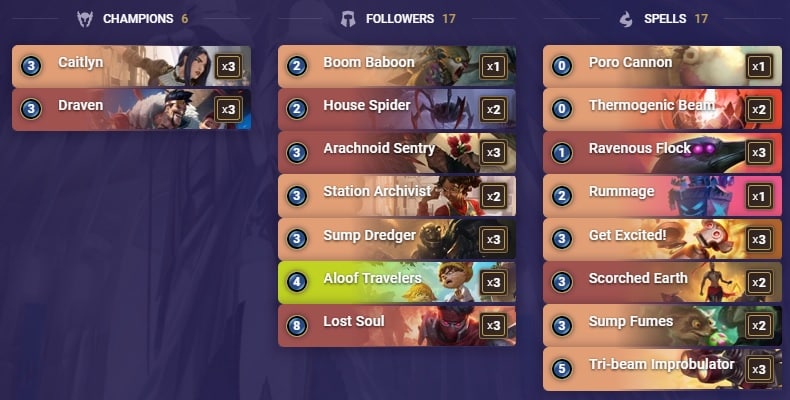Welcome to TLG’s latest meta snapshot for Legends of Runeterra, a series in which we give you our insight on the finest decks in the higher ranks of the ladder.
Every Monday, we discuss the decks that are part of the week’s meta and rate them on a scale of 1 to 5 stars. We also look at the evolution of said decks’ ratings across weeks and draw conclusions regarding the current state of the game, all of this so you can delve into your own ranked journey with a head start.
The post-Worlds environment has led to a new predator entering the fray in the top tier: Ziggs-Poppy. We now have a bit of a rock-paper-scissors affair in Tier 1, with Ziggs-Poppy there as a counter to Zoe-Nami and Zoe-Nami there as a counter to Draven-Sion.
In the most recent EU Masters games, we could see a returning archetype - Thralls. They’ve adapted, hoping that a greater flexibility allows them greater longevity in the meta this time around. With one returner comes one that Ultraman advises you to relinquish - Caitlyn-Draven seems to have run its course.
If you have any questions, feel free to drop by our Discord. Best of luck on your climb!
Graphics: WellMax81
Editing: Wusubi, Sebodunum
Writers: Den, Ultraman, Othal

CECACAIDCQAQIBAQAQAQIJRHFU2AIBIDAECAMDIEAEAQIAIBAMBQ6AIDAQJACBIDBEBACAIDEMAQGAYN
Difficulty: Easy
Draven-Sion is well-known as one of the meta staples since the start of this patch, heavily countering Demacia while retaining good matchups against most of the field. With Ziggs-Poppy’s rise in play rate, the deck has gained another excellent matchup. This has ensured that Sion’s brutal dominance won’t wane and that he’ll retain his top tier crown for the foreseeable future.
With a high win rate, great stability and a polished game plan with a nice learning curve, the list offers outplay possibilities with relatively little investment. This gives you the kind of flexibility that the other Tier 1 decks lack. Other versions of the deck can include Aloof Travelers, Arachnoid Sentry or Ravenous Flock. These inclusions slow down the deck in order to do better against Aggro or Control matchups.
As ever, though, they’ll only be effective if employed astutely alongside the deck’s main threats. This could mean putting more emphasis on leveling-up Draven, on putting pedal to the metal for an aggressive start, or relying on Sion to enter the fray as your main damage dealer!
Something that has helped the deck is that its main counters turned out to be less threatening than expected. For example, Bandle Gangplank has ended up being an almost even matchup and Darkness also goes toe-to-toe with the deck instead of trashing it as predicted. (Write-up by Ultraman)
CICQCAQGDAAQGBQRAECAMDQCAUDAKCYHAMEQSIZIFIZWFVYBAABAEAQGDUWQEAYJKVNQ
Difficulty: Moderate
Touted as the best deck in the game for many weeks, Zoe-Nami finally seems to have found a reliable counter in the form of Ziggs-Poppy, bringing the Bilgewater mermaid down in power level. With Draven-Sion still being a deck, however, Nami decks shouldn’t go too far from the top in the future. Even if their win rate has lowered a bit, the deck stays as a decent Tier 1 option.
The list is still very good; there are very few decks capable of beating it when the stars align (e.g. Nami comes down leveled-up on Turn 4 alongside a Sparklefly or Zoe). But it’s still undeniable that the relatively faster environment that we’re in has hurt the overall stock of the deck.
As such, Zoe-Nami has stopped playing greedy options like Mind Meld, and is working on its reliability in order to consistently find Nami and the deck’s best targets for its buffs. If the 3 copies of Gifts from Beyond have been a constant staple in the deck, the newer inclusion of Salvage is interesting. The Toss mechanic may not seem useful in a non-Deep deck, but the fact that it doesn’t affect champions makes finding Nami more likely later on.
Gameplay-wise, the deck’s focus should be on maximizing its win rate against faster matchups. It’s already good against decks that allow it time to develop, so aiming to take on the faster ones will be the way forward. Learning when to take risks, which resources are vital and which can be sacrificed is key to navigating the deck’s most difficult matchups.
With the Seasonal tourney at the end of the week, there’s no doubt Nami will be one of the decks to watch, as its performance could be stellar or disappointing depending on what decks are the most popular during the open rounds. (Write-up by den)
CQBQEAQDAMCAGAIDAIGCQCAFBIDSSMKJMB2KGANGAEAACAIFBJCQ
Difficulty: Easy
Aggro decks have had a tough time in the current meta. Sion Discard has been a huge problem to overcome for decks looking to build early pressure and get an ongoing damage flow. As such, Draven has acted as a gatekeeper, preventing most damage archetypes to prevail for weeks, protecting Midrange decks in the process.
Since Nami has taken over as the top deck, more early development has been possible. This is because Nami decks are much worse than Draven-Sion at denying a strong early game board.
Ziggs represents the damage part of the deck, as paired with the Noxus units and the Impact mechanic, he can inflict a steady flow of damage and pressure - even when blocked. Poppy is a snowball champion, allowing for a more board-centric approach against decks that could nullify the Ziggs-led damage line of play thanks to healing or stalling effects. With the flurry of units we can develop through the Bandle region, Poppy always finds a couple of friends to buff with her ability.
The other thing that separates the deck from other aggressive decks, and most of the reason why Ziggs-Poppy managed to reach Tier 1 while decks like Pirates are stuck in Tier 3, is the card generation that Bandle provides. Having a deck that can pack some aggression but also sustain itself for much longer is something new that a lot of Midrange decks struggle with.
In most cases when facing Aggro decks, if you manage to stay afloat until Turn 5 or 6, the aggression naturally reduces and you can turn things around and aim to finish the game before they can draw into their direct damage. In the case of Ziggs-Poppy, cards like Bandle City Mayor and Conchologist manage to maintain the pressure and feed the deck with options, buying more time to draw into a Decimate finisher. (Write-up by den)

CMBQCAYABYBACAAJDUDQIBYNCQ3GPAABQEAYEAIDAEBAAAIBAQAAEAQEA5OYUAICAEAQAGQBAQAAG
Difficulty: Moderate
Once the uncontested best deck in the game, Akshan-Sivir has never quite returned to domination after Draven-Sion and its nerfs made its overall win rate plummet. However, it hasn’t fallen too far - it’s still one of the best Midrange decks.
Sivir remains one of the toughest champions to remove, and Demacia provides supporting tools to maximize her effectiveness. She’s used as both a pressure and a removal in the deck, with her impactfulness making the player feel that drawing her is the only way to win a game.
Thanks to Akshan, Vekauran Vagabond and Preservarium, finding Sivir happens more often than not, enabling the whole deck to be much stronger overall. Firstly, her level-up still represents one of the biggest threats of the current meta, as support cards like Brightsteel Protector or The Absolver allow for the entire board to gain a shield and Overwhelm if given to Sivir.
Secondly, with Vekauran Bruiser replacing Ruin Runner, Sivir is the best target for the Lucky Finds he produces when he strikes. The other tools in the deck are geared towards controlling tempo. For example, the Challenger and Vulnerable keywords are great against board-centric decks, while the Rally possibility forces the defensive decks to be careful with how much freedom they give to the deck.
This mix of draw, tempo tools and Demacian removals makes Akshan-Sivir a solid contender. The deck might lack some power since its nerfs and can feel a bit weak when compared to Nami or Poppy decks. Yet, its flexibility is still second to none when it comes to reliably finding ways to develop in any matchup. (Write-up by den)
CQBQCBIGAECQKCQHIVEWBJQBAYBAMBA2D4QC2PACAEBAMEQBAUFBUAA
Difficulty: Easy
Bandle Gangplank’s inception came about with the precise intention for it to act as a counter to Draven-Sion. However, it has ended up being a list that has some stability and good matchups. It’s good at what it does! Sadly, that isn’t always enough to win, as it lacks the extra push of a deck like Ziggs-Poppy, and the unreliable Double Up struggles to make up for that.
While this “counter” role wasn’t the deck’s true calling, it managed to improve most of its bad matchups with time, going 50/50 against Ziggs-Poppy, Akshan-Sivir and GP-Sejuani. With its low curve and Bandle’s ability to not run out of resources, the deck will slowly damage the opposing Nexus, forcing the opponent into riskier and riskier plays and inviting them to try and trade all of your followers on board.
Many of these followers pack the Impact keyword and apply pressure with each attack. Lecturing Yordle, while lacking Impact, offers the same pressure when attacking, as apart from its good statline, it also creates a Poison Dart that acts as another poke tool and can deal some extra damage later on through Mushrooms.
The deck’s main finisher is Gangplank. He can level-up rapidly in this list, threatening your opponent with deadly board clears and direct damage thanks to his Overwhelm. Double Up is a hit or miss, as against some matchups the card is almost godlike, while it can be extremely hard to place against others like Demacia and its cheap combat tricks. (Write-up by Ultraman)
CQCACAYABYAQGAQCAMAQACIVDUCQKCRJOSTQDLYB5MAQGAICAADQCBAAAIBAKCTAN4BACAIAEUAQKCURAE
Difficulty: Easy
Rally decks have had a tough time recently. Just like Akshan-Sivir, the popularity of Draven-Sion has slowed down board-centric decks and their ability to develop their strategy reliably. But there are a lot of upsides to pressure-oriented decks - for instance, they’re strong against Nami and Control decks.
There still is debate on what is the best Rally deck out there, as 3 champions and 3 regions are battling to be amongst the two that players pick. As we’re looking to prey on decks letting us develop onto the board early, it looks like Bandle has more upside than Ionia, leaving Zed out of the equation.
In this Bandle/Demacia take on the Rally archetype, our goal is to have constant board development and to keep threatening the opponent with Rallies and a potential Yordles in Arms. As usual, there are more important pieces than others to keep alive.
Poppy, Lulu, Bandle City Mayor or the Bandle Commando can have game-winning impact if they manage to stay on the board for several turns. But as our opponents are aware of this, it doesn’t mean they can save their removal for the “must-kill” units.
The deck should always have some units on the board to chip in damage over time. The accumulation of such damage can lead to opponents having to use their removal inefficiently just to survive, which allows bigger threats to emerge unscathed.
As such, the only reliable counter to Lulu-Poppy is out-tempoing it and stopping the flow of units it can produce, forcing the deck onto the defensive. Although the newer Aggro Bandle decks represent a problem alongside Draven-Sion, there are still plenty of decks for you to prey upon. (Write-up by den)
CICACAQBAIAQGBQIAECAMCQHAIDAWIBBEYWTUPACAECQMAIDAIDBEFBCAIAQEBQCAEBQCFQ
Difficulty: Moderate
Kind of absent from ladder recently, Plunder came back in several line-ups at Worlds and reminded a lot of players why it can still be a decent deck. Although not on par with the very best decks on ladder, the popularity of board-centric decks makes Plunder an interesting choice to punish them, as both of its champions still pack a considerable punch.
The fast-paced ladder environment is something the deck still needs to adapt to, though. The recent arrivals of Ziggs-Poppy and Bandle Gangplank, for example, are difficult to handle for Midrange decks without healing capacities. In those matchups, Plunder can answer the board, but can’t stop the flow of damage, having to resort to a race in which it’s the slower contestant.
During Worlds, we also saw the rise of some quite unexpected Control decks with Darkness and Feel The Rush having a great showing during the tournament. This could be good news for Plunder, as the deck is much better in those slower matchups, where it can develop its game plan and pressure the opponent for an extended period.
Including 1 copy of Feel the Rush is something that two American players decided to play during Worlds. Replacing a copy of The Dreadway, the card can change the dynamic of the late game, allowing you to use spells more liberally. That’s because you don’t need to save up spells until you have The Dreadway on board in order to maximize its ability.
Mixing those threats might be what will save Plunder in this meta, as being able to pressure the opponent is Plunder’s saving grace in a lot of matchups, especially the slower ones. The deck needs to solve one problem now, however; Aloof Travelers is a veritable menace to this deck, as it consistently removes your champion or one of the finishers. (Write-up by den)
CEBQQBIKAQNDCOK5LZRKMAIBAECSQAQFAUEASAQCAUFADUIBAEAQKFABAEAQKHI
Difficulty: Hard
Darkness is better than ever, which might come as a surprise! It’s comparable to Lee Sin, in that it can be a top performing deck if played perfectly. It’s hard to evaluate the deck, given the huge gap between what brilliant Darkness players can do compared to regular players, especially when it comes down to matchups. What might be seen in the eyes of a professional player as an easy encounter may very much not be the case lower down the ladder.
But if you can manage to efficiently set-up Veigar and Senna (e.g. with Stilted Robemaker, Twisted Catalyzer), you can come back from slow starts almost unstoppably, constantly dealing with anything your opponent can throw at you, as you have all the answers you’ll ever need, waiting to be used.
Your main problem is tempo, as all those answers are expensive, so you’ll have to know when to answer the opposing threats, which ones and why. You’ll need a deep knowledge of the meta and the opponent’s possibilities when it comes down to lethal, as you’re always spending a lot of mana to answer anything.
As such, you expose yourself to crazy combos like Yordles in Arms plus a Rally, an Atrocity or some Ezreal/Shellfolk shenanigans. You’ll have to keep an eye out for these surprise lethals that can derail your evil plans in an instant. (Write-up by Ultraman)
CIBQCAICBQCQEAQDAUDAQCIFAMEQSGZDGPLQCAQBAMBBIAIEAIKAEAIDBFKQEAICAIYQ
Difficulty: Hard
While the naysayers proclaimed the death of Lee Sin with the introduction of Aloof Travelers and Minimorph, the Blind Monk proves that his title spell might have to be renamed Phoenix’s Rage, as he rises once again and finds his place on the ladder!
After his brief dalliance with Akshan, he went back to his best pairing to date: Zoe. With a slow game plan and a hard set-up being Lee Sin’s trademark, Targon provides the necessary tools to survive the early game in the form of Gifts from Beyond, accompanied by Eye of the Dragon.
Targon also brings its fair share of draw engines like Guiding Touch, Pale Cascade and Zenith Blade, aloing with flurry of cheap spells to help you proc Eye of the Dragon and Deep Meditation. Hush is a decent addition in the current meta, preventing Sion from coming back, turning a 10/10 Elusive/Lifesteal unit into a 2/1, or making sure Poppy isn’t boosting a full board this turn.
Ionia brings its own fair share of tricks, with cards like Twin Disciplines and Concussive Palm allowing you to choose your own battles, protect your key units or slow down the game to your own tempo. You can even boost a Dragonling to get a bigger Lifesteal and get back in the game.
Burn decks like Ziggs-Poppy are popular and will be hard to defeat without Lifesteal, so plan your turns to spawn Dragonlings as frequently as possible - and mostly in your opponent’s turn to get chump blockers and some health back. If you can slow the game sufficiently, no card in these matchups can threaten your Lee Sin and with his Dragon Kick and Barrier, he’ll prove to be the most dangerous card on the board.
This deck is one of the hardest to play in the whole game, so don’t be discouraged if you don’t succeed at first. Have faith in the dragon spirit and remember that struggle is another step on the path to greatness. (Write-up by Othal)
CQBQCAIDG4AQEAYJBECQUALUQQAZQANGAGTQDLYBYIA4MAICAEBAMLQCAUFCTQABAEAQKCVAAE
Difficulty: Moderate
Fizz-Poppy’s trajectory has been pretty wild - it went from being a meme all the way to being one of the meta’s finest decks. Now, it’s retreating back down to being a niche and a somewhat rigid deck. Despite being played a lot, the deck has polarized matchups and suffers against the Tier 1 decks, having a hard time against both Zoe-Nami and Ziggs-Poppy.
This all stems from the deck’s win con, as it’s unable to win with pressure or Control and must set-up The Bandle Tree and play 10 units from different regions to win. As such, it gives the more aggressive opponents a lot of time to deal the finishing blow, especially since it doesn’t have any healing other than creating random cards from Loping Telescope or The Bandle Tree itself.
Obviously, in tourneys, the deck fares better in an anti-control line-up, retaining a great matchups against FTR and Darkness. However, the same cannot be said for its matchup into Shellfolk, as it packs both Scorched Earth and Aftershock, which can obviously be disastrous for a landmark-based deck. (Write-up by Ultraman)
CECACBABBYBACBJIGYBAGAIGCYCACAIDCQTTEAYBAEAQYAIEAUOQGAIFCMMR2AQBAMAQEAQBAUAQ6
Difficulty: Hard
Well, here’s another all-in Control deck with a very rigid game plan. Like the others, it’s difficult to play in a meta where decks can play up to 5 cards a turn, punishing you each time you answer the wrong threats. You don’t have the right to fail, and any mistake will lose you the tempo you need to win.
Since you can’t answer every threat, you’ll have to make choices - what will you ignore, what will you remove? Outside of that, it’s a classic control deck, punishing developed boards with AoE and open attacks with fast removal, and some extra ramp to get to the win condition, Feel The Rush, faster.
FTR offers you two gigantic champions, and, if Trundle is leveled-up, two gigantic champions with Overwhelm. This should be enough to destroy a Nexus almost from scratch, but watch out for those last turns. Nowadays, decks have answers available for these threats, such as Minimorph, Hush or stuns like Concussive Palm.
Atrocity is another means to deal Nexus damage, but you’ll need to watch out for the same threats mentioned earlier. Although it can be a devastating finisher, often it can be sitting there burning a hole in your hand when you’d much rather have healing or a board clear. (Write-up by Ultraman)
CMBAGBAHD4WEEBAEAEAQKBQOAMAQIAIKAIAQCCZSAQCAODJCJF4AGAIDAEBAEAIBAEKAEBAHHNUA
Difficulty: Hard
The recent EU Masters scene saw the revival of an old and somewhat forgotten archetype. Similar to The Bandle Tree, it’s mostly an anti-control list. This time, however, it aims to have a more flexible approach, which comes at the cost of early game pressure and answers to early aggression. Instead, the deck relies on AoE removals (Blighted Ravine, Avalanche) and Lissandra’s level-up to soak up some damage.
It also has some healing, with Kindly Tavernkeeper and Blighted Ravine helping you stay alive until your win con comes to life; lots of Thralls! They have an 8-turn timer that can be accelerated by using cards such as Draklorn Inquisitor or Time in a Bottle. Promising Future allows you to double the effects of these landmarks, which feeds into the main aim with this list - to create as many 8/8 Overwhelm units as quickly as possible.
Taliyah can help with his, of course. If you can do all that, then the opponent will find themselves in an extremely difficult spot; any miscalculation and their Nexus will be shattered. While playing this deck can do wonders for your win rate, you should also be prepared to suffer in the Aggro-filled ladder with a scary Tier 1 that won’t give any breathing room. (Write-up by Ultraman)

CQCACAICBQAQEBROAIBAEAYGA4CQUBAFDIUCUMNGAEBACAICHEBAEAQFBEAQCAYCCQ
Difficulty: Moderate
When you think a region is too strong, it can be tested by slapping some of its cards in a well-known archetype and seeing if it works out. This seems to be the philosophy that brought this deck to life, and it actually has had some success on the ladder!
Bandle City provides cheap spells to trigger both Fizz and Lee Sin’s level-ups, and you should be able to swarm the board in the early game with Otterpus and Elusive cards like Kelp Maidens or Fizz himself. Pranks will ensure you get more value from your cards than the opponent, while you should always have something to play to chip away some Nexus health.
Against Burn decks that are prominent on the ladder, Eye of the Dragon and Otterpus will help you stay healthy and provide chump blockers that can be boosted with Purpleberry Shake for more durability or more Lifesteal. While the regular Lee Sin build has a ombo finisher, here the Blind Monk is merely part of a bigger machine, and is used as Burn and removal.
When he hits the board, he should already be leveled-up (or close to it) and you can easily proc two spells per turn to have his Challenger and Barrier up. But the lack of Overwhelm in Bandle City and Ionia will have you deal less damage and prevent you from the flashy finisher that Lee Sin players are accustomed to.
At this point, there are two options for you: either you’ve already got the Nexus low enough for Lee Sin to finish the job without Overwhelm, or you’ll enter a grindy war of attrition, Dragon Kicking units each turn and dealing damage to the opposing Nexus. All the while, your Lee should prove a pain to remove.
While this deck is good for fun and games and has a lot of shenanigans to try, its surprise value is long gone, and it still remains weaker than the usual Lee Sin decks. As such, I would advise against playing it if your only goal is to climb. (Write-up by Othal)
CQCACAQEBAAQKBARAIAQIJBUA4CQUBBIGGMADJQBV4A3YAIDAEAQIGYBAQCAOAIFBIAQCAIDAQFQ
Difficulty: Hard
Brought to light by Alanzq during his winning run at Worlds, Curious Shellfolk was mostly known for its bug until last week. Now that it has been fixed, the deck can be judged for what it really is, and it honestly looks good so far. Probably one of the hardest decks to pilot well on our list this week, Shellfolk is first and foremost a defensive deck’s worst nightmare, as it can generate way too much value if left alone for too long.
But the reason why the deck can pride itself on being relevant in the current meta is its capacity to deny the opposing tempo, buying enough time to develop Shellfolk and then out-tempoing pretty much anyone. Once Shellfolk is in play, your Pranks will also give you a copy of the pranked card reduced by one.
In addition, your “Manifest cards” will essentially double their effect, which in this deck’s case is mostly Trinket Trade giving you 2x Otterpus, fueling your Shellfolk with even more Pranks. Once that train is chugging along, it’s almost impossible to derail it, as the opponent’s hand is revealed and costs more and more, while the Shellfolk player keeps refilling.
Because of that crazy late game potential, the deck is mostly focused on stabilizing the early game as safely as possible, and with neither Bandle nor PnZ having access to healing, that can be a bit difficult against decks with a heavy damage potential.
For now, the deck isn’t popular on ladder, as it has rough matchups against the popular Zoe-Nami and Sion Discard. It looks better against the more “on curve” decks, which are weaker to the PnZ removal package, granting you more time to set up Shellfolk on the board.
The deck is a complicated one to pilot and it’ll probably take double digit games before being able to sense the real potential you could have when playing it. I can assure you that it’s worth the trouble, however, as it’s very satisfying to achieve the full synergy. This list is certainly something to keep an eye on in terms of its evolution over the coming weeks. (Write-up by den)
CQDQCAQDBEAQGBARAECQVGABAECQGCIBAUCAMAQBAMKC4AQBAQTCOBABAEBTOAIBAQNQCAYDBUBAKBAMCEBQCAIEAEAQGBASAECAIEA
Difficulty: Moderate
I can’t wrap my head around the fact that, somehow, Caitlyn-Draven still sees play. The deck is clunky and only perfect hands are able to resist most of the good decks in this meta. It’s not good into Aggro, not good into Control and only barely ahead of Midrange decks at the moment. It can beat Demacia consistently, but that’s basically it.
You have to find Lost Soul so as to not empty your hand too fast, but you also need Tri-beam Improbulator and some 3-cost cards to have a win condition in the first place. Moreover, you must draw control tools such as Ravenous Flock to stop your opponent’s pressure.
It’s true that with an ideal hand, you can make even the toughest opponent helpless, but I’m sure you understand how hard and rare it is to get every piece of the puzzle you need to set the deck up properly.
With Caitlyn, your goal is to tire the opponent out. You can’t finish their Nexus with direct damage like Ezreal could, and you aren’t afforded the safety of Captain Farron and his two Decimates. It’s on, it’s raw and it’s followers versus answers until one of the players doesn’t have any cards left to play.
That’s often going to be you, if you don’t find Lost Soul for extra value. Your lack of healing makes long games a problem, as the opponent always has the opportunity to just go for your Nexus. The longer the game goes on, the higher the possibility of them topdecking the card you’re scared of, ruining your valiant and prolonged efforts at handling their board.
This good ol’ reliable archetype is just not reliable anymore, and I’d advise players to finally let it rest. Piltover/Noxus offers many better decks, so try them! (Write-up by Ultraman)
